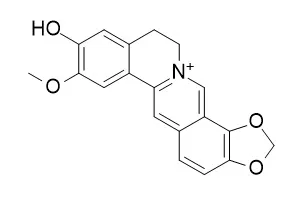| Kinase Assay: |
| Biol Pharm Bull. 2009 Aug;32(8):1433-8. | | Anti-Alzheimer and antioxidant activities of Coptidis Rhizoma alkaloids.[Pubmed: 19652386] | Coptidis Rhizoma and its isolated alkaloids are reported to possess a variety of activities, including neuroprotective and antioxidant effects.
METHODS AND RESULTS:
Thus, the anti-Alzheimer and antioxidant effects of six protoberberine alkaloids (berberine, palmatine, jateorrhizine, epiberberine, coptisine, and Groenlandicine) and one aporphine alkaloid (magnoflorine) from Coptidis Rhizoma were evaluated via beta-site amyloid precursor protein (APP) cleaving enzyme 1 (BACE1), acetylcholinesterase (AChE), and butyrylcholinesterase (BChE) assays, along with peroxynitrite (ONOO(-)) scavenging and total reactive oxygen species (ROS) inhibitory assays.
Six protoberberine alkaloids exhibited predominant cholinesterases (ChEs) inhibitory effects with IC(50) values ranging between 0.44-1.07 microM for AChE and 3.32-6.84 microM for BChE; only epiberberine (K(i)=10.0) and Groenlandicine (K(i)=21.2) exerted good, non-competitive BACE1 inhibitory activities with IC(50) values of 8.55 and 19.68 microM, respectively. In two antioxidant assays, jateorrhizine and Groenlandicine exhibited significant ONOO(-) scavenging activities with IC(50) values of 0.78 and 0.84 microM, respectively; coptisine and Groenlandicine exhibited moderate total ROS inhibitory activities with IC(50) values of 48.93 and 51.78 microM, respectively.
CONCLUSIONS:
These results indicate that Coptidis Rhizoma alkaloids have a strong potential of inhibition and prevention of Alzheimer's disease (AD) mainly through both ChEs and beta-amyloids pathways, and additionally through antioxidant capacities. In particular, Groenlandicine may be a promising anti-AD agent due to its potent inhibitory activity of both ChEs and beta-amyloids formation, as well as marked ONOO(-) scavenging and good ROS inhibitory capacities. As a result, Coptidis Rhizoma and the alkaloids contained therein would clearly have beneficial uses in the development of therapeutic and preventive agents for AD and oxidative stress-related disease. | | Arch Pharm Res. 2008 Nov;31(11):1405-12. | | Inhibitory activities of the alkaloids from Coptidis Rhizoma against aldose reductase.[Pubmed: 19023536] | As part of our ongoing search of natural sources for therapeutic and preventive agents for diabetic complications, the rat lens aldose reductase (RLAR) inhibitory effect of Coptidis Rhizoma (the rhizome of Coptis chinensis Franch) was evaluated.
METHODS AND RESULTS:
Its extract and fractions exhibited broad and moderate RLAR inhibitory activities of 38.9 approximately 67.5 microg/mL. In an attempt to identify bioactive components, six quaternary protoberberine-type alkaloids (berberine, palmatine, jateorrhizine, epiberberine, coptisine, and Groenlandicine) and one quaternary aporphine-type alkaloid (magnoflorine) were isolated from the most active n-BuOH fraction, and the chemical structures therein were elucidated on the basis of spectroscopic evidence and comparison with published data. The anti-diabetic complications capacities of seven C. chinensis-derived alkaloids were evaluated via RLAR and human recombinant AR (HRAR) inhibitory assays. Although berberine and palmatine were previously reported as prime contributors to AR inhibition, these two major components exhibited no AR inhibitory effects at a higher concentration of 50 microg/ml in the present study. Conversely, epiberberine, coptisine, and Groenlandicine exhibited moderate inhibitory effects with IC(50) values of 100.1, 118.4, 140.1 microM for RLAR and 168.1, 187.3, 154.2 microM for HRAR.
CONCLUSIONS:
The results clearly indicated that the presence of the dioxymethylene group in the D ring and the oxidized form of the dioxymethylene group in the A ring were partly responsible for the AR inhibitory activities of protoberberine-type alkaloids. Therefore, Coptidis Rhizoma, and the alkaloids contained therein, would clearly have beneficial uses in the development of therapeutic and preventive agents for diabetic complications and diabetes mellitus. |
|






 Cell. 2018 Jan 11;172(1-2):249-261.e12. doi: 10.1016/j.cell.2017.12.019.IF=36.216(2019)
Cell. 2018 Jan 11;172(1-2):249-261.e12. doi: 10.1016/j.cell.2017.12.019.IF=36.216(2019) Cell Metab. 2020 Mar 3;31(3):534-548.e5. doi: 10.1016/j.cmet.2020.01.002.IF=22.415(2019)
Cell Metab. 2020 Mar 3;31(3):534-548.e5. doi: 10.1016/j.cmet.2020.01.002.IF=22.415(2019) Mol Cell. 2017 Nov 16;68(4):673-685.e6. doi: 10.1016/j.molcel.2017.10.022.IF=14.548(2019)
Mol Cell. 2017 Nov 16;68(4):673-685.e6. doi: 10.1016/j.molcel.2017.10.022.IF=14.548(2019)